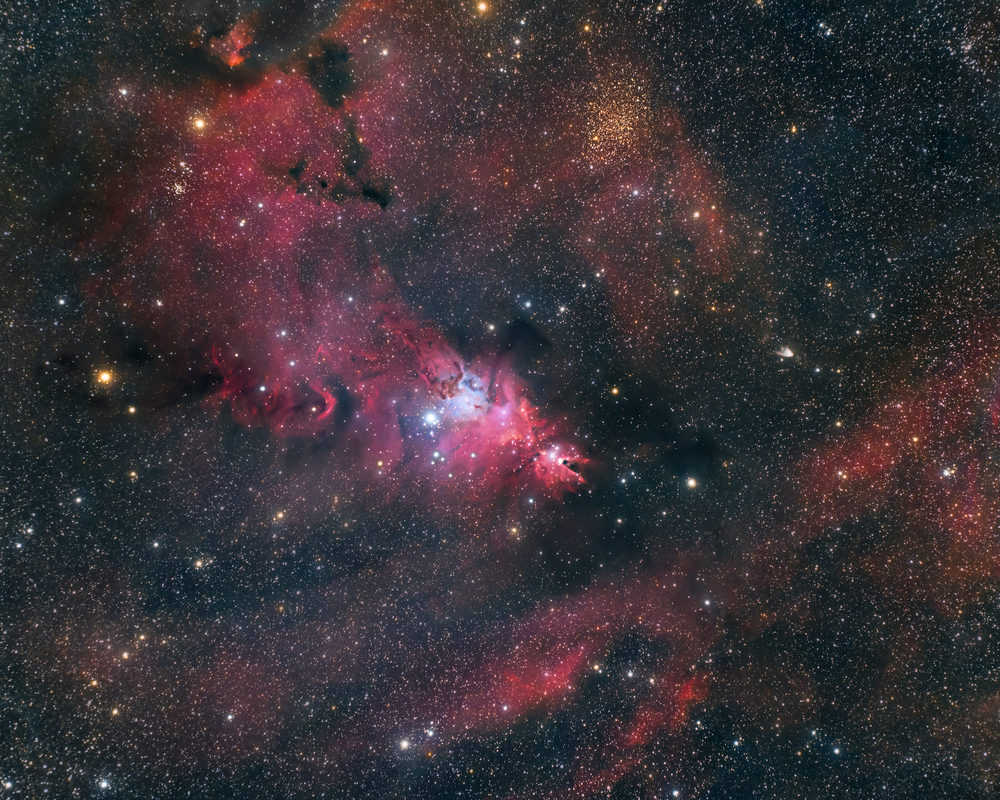Blog
Emmanuel N’Djoké Dibango (born 12 December 1933) is a Cameroonian musician and songwriter who plays saxophone and vibraphone. He developed a musical style fusing jazz, funk, and traditional Cameroonian music. His father was a member of the Yabassi ethnic group, though his mother was a Duala. He is best known for his 1972 single “Soul Makossa“.
Dibango was born in Douala, Cameroon. His father, Michel Manfred N’Djoké Dibango, was a civil servant. Son of a farmer, he met his wife travelling by pirogue to her residence, Douala. A literate woman, she was a fashion designer, running her own small business. Both her ethnic group, the Duala, and his, the Yabassi, viewed this union of different ethnic groups with some disdain. Emmanuel had no siblings, although he had a stepbrother from his father’s previous marriage who was four years older than he was. In Cameroon, one’s ethnicity is dictated by one’s father, though Dibango wrote in his autobiography, Three Kilos of Coffee, that he has “never been able to identify completely with either of [his] parents.”
Dibango’s uncle was the leader of his extended family. Upon his death, Dibango’s father refused to take over, as he never fully initiated his son into the Yabassi’s customs. Throughout his childhood, Dibango slowly forgot the Yabassi language in favour of the Duala. However, his family did live in the Yabassi encampment on the Yabassi plateau, close to the Wouri River in central Douala. While a child, Dibango attended Protestant church every night for religious education, or nkouaida. He enjoyed studying music there, and reportedly was a fast learner.
more...William Henry “Chick” Webb (February 10, 1905–June 16, 1939) was an American jazz and swing music drummer as well as a band leader.
Webb was born in Baltimore, Maryland, to William H. and Marie Webb. When an infant, he fell down some stair steps in his family’s home, crushing several vertebrae and requiring surgery, from which he never regained full mobility. The injury progressed to tuberculosis of the spine, leaving him with short stature and a badly deformed spine which caused him to appear hunchbacked.The idea of playing an instrument was suggested by his doctor to “loosen up” his bones. He supported himself as a newspaper boy to save enough money to buy drums, and first played professionally at age 11. Webb had three sisters: Bessie, Mabel and Ethel. Mabel married Wilbur Porter around 1928.
At the age of 17 he moved to New York City and by 1926 was leading his own band in Harlem. Jazz drummer Tommy Benford said he gave Webb drum lessons when he first reached New York.
He alternated between band tours and residencies at New York City clubs through the late 1920s. In 1931, his band became the house band at the Savoy Ballroom. He became one of the best-regarded bandleaders and drummers of the new “swing” style. Drummer Buddy Rich cited Webb’s powerful technique and virtuoso performances as heavily influential on his own drumming, and even referred to Webb as “the daddy of them all”. Webb was unable to read music, and instead memorized the arrangements played by the band and conducted from a platform in the center. He used custom-made pedals, goose-neck cymbal holders, a 28-inch bass drum and other percussion instruments.
Although his band was not as influential, it was feared in the battle of the bands. The Savoy often featured “Battle of the Bands” where Webb’s band would compete with other top bands, such as the Benny Goodman Orchestra or the Count Basie Orchestra. By the end of the night’s battles the dancers seemed always to have voted Webb’s band as the best. Webb lost to Duke Ellington in 1937. Although a judge declared Webb’s band the official winner in 1938 over Count Basie’s, and Basie himself said he was relieved to come away from the contest without embarrassing himself, surviving musicians continued to dispute the ruling for decades.
more...https://www.youtube.com/watch?v=dvDpYBFcLyQ
more...https://www.youtube.com/watch?v=GW-ffdHybQY
more...NGC 7541, seen here as viewed by the NASA/ESA Hubble Space Telescope, in the constellation of Pisces (The Fishes).
A barred spiral is a galaxy with whirling, pinwheeling, spiral arms, and a bright center that is intersected by a bar of gas and stars. This bar cuts directly through the galaxy’s central region, and is thought to invigorate the region somewhat, sparking activity and fuelling myriad processes that may otherwise have never occurred or have previously ground to a halt (star formation and active galactic nuclei being key examples). We think bars exist in up to two-thirds of all spiral galaxies, including our own home, the Milky Way.
NGC 7541 is actually observed to have a higher-than-usual star formation rate, adding weight to the theory that spiral bars act as stellar nurseries, corralling and funneling inwards the material and fuel needed to create and nurture new baby stars. Along with its nearby companion NGC 7537, the galaxy makes up a pair of galaxies located about 110 million light-years away from us.

Carole King (born Carol Joan Klein, February 9, 1942) is an American singer-songwriter who has been active since 1958, initially as one of the staff songwriters at the Brill Building and later as a solo artist. She is the most successful female songwriter of the latter half of the 20th century in the US, having written or co-written 118 pop hits on the Billboard Hot 100. King also wrote 61 hits that charted in the UK, making her the most successful female songwriter on the UK singles charts between 1952 and 2005.
King’s major success began in the 1960s when she and her first husband, Gerry Goffin, wrote more than two dozen chart hits, many of which have become standards, for numerous artists. She has continued writing for other artists since then. King’s success as a performer in her own right did not come until the 1970s, when she sang her own songs, accompanying herself on the piano, in a series of albums and concerts. After experiencing commercial disappointment with her debut album Writer, King scored her breakthrough with the album Tapestry, which topped the U.S. album chart for 15 weeks in 1971 and remained on the charts for more than six years.
King has made 25 solo albums, the most successful being Tapestry, which held the record for most weeks at No. 1 by a female artist for more than 20 years. Her record sales were estimated at more than 75 million copies worldwide. She has won four Grammy Awards and was inducted into the Songwriters Hall of Fame and the Rock and Roll Hall of Fame for her songwriting. She is the recipient of the 2013 Library of Congress Gershwin Prizefor Popular Song, the first woman to be so honored. She is also a 2015 Kennedy Center Honoree. King was born as Carol Joan Klein in February 1942 in Manhattan to a Jewish family.
more...Ernest Dale Tubb (February 9, 1914 – September 6, 1984), nicknamed the Texas Troubadour, was an American singer and songwriter and one of the pioneers of country music. His biggest career hit song, “Walking the Floor Over You” (1941), marked the rise of the honky tonk style of music.
In 1948 he was the first singer to record a hit version of Billy Hayes and Jay W. Johnson’s “Blue Christmas“, a song more commonly associated with Elvis Presley and his late-1950s version. Another well-known Tubb hit was “Waltz Across Texas” (1965) (written by his nephew Quanah Talmadge Tubb, known professionally as Billy Talmadge), which became one of his most requested songs and is often used in dance halls throughout Texasduring waltz lessons. Tubb recorded duets with the then up-and-coming Loretta Lynn in the early 1960s, including their hit “Sweet Thang”. Tubb is a member of the Country Music Hall of Fame.
Tubb was born on a cotton farm near Crisp, in Ellis County, Texas (now a ghost town). His father was a sharecropper, so Tubb spent his youth working on farms throughout the state.
https://www.youtube.com/watch?v=troL2Toww24
more...
Walter Sylvester Page (February 9, 1900 – December 20, 1957) was an American jazz multi-instrumentalist and bandleader, best known for his groundbreaking work as a double bass player with Walter Page’s Blue Devils and the Count Basie Orchestra.
Page was born in Gallatin, Missouri on February 9, 1900 to parents Edward and Blanche Page. Page showed a love for music even as a child, perhaps due in part to the influence of his aunt Lillie, a music teacher. Page’s mother, with whom he moved to Kansas City in 1910, exposed him to folksongs and spirituals, a critical foundation for developing his love of music. He gained his first musical experience as a bass drum and bass horn player in the brass bands of his neighborhood.
After Page had completed high school, he went on to study to become a music teacher at the University of Kansas at Lawrence. At college, Page completed a three-year course in music in one year, in addition to taking a three-year course on gas engines. Between the years 1918 and 1923, he moonlighted as a tuba, bass saxophone, and string bass player with the Bennie Moten Orchestra. “Fridays and Sundays I played with Bennie Moten and Saturdays with Dave Lewis who was paying me $7.00 a night. Bennie was paying for my food and transportation, so when I’d be finished a weekend [sic] I’d made me $20.00 and had a ball.”
In 1923, Page left the Moten band and began an engagement with Billy King’s Road Show, touring the Theater Owners’ Booking Association (TOBA) circuit across the United States. The band included Page’s future Basie band mates Jimmy Rushing and Count Basie himself.
more...Performing Monday 2-10-2020
Capitol Hill Magnet School in St Paul 1015 & 1130am
with Joe Shalita, Bingo Sei Kpolar & mick laBriola

Interstellar clouds of hydrogen gas and dust abound in this gorgeous skyscape. The 3 degree wide field of view stretches through the faint but fanciful constellation Monoceros, the Unicorn. A star forming region cataloged as NGC 2264 is centered, a complex jumble of cosmic gas, dust and stars about 2,700 light-years distant. It mixes reddish emission nebulae excited by energetic light from newborn stars with dark dust clouds. Where the otherwise obscuring dust clouds lie close to hot, young stars they also reflect starlight, forming blue reflection nebulae. A few light-years across, a simple sculpted shape known as the Cone Nebula is near center. Outlined by the red glow of hydrogen gas, the cone points toward the left and bright, blue-white S Monocerotis. Itself a multiple system of massive, hot stars S Mon is adjacent to bluish reflection nebulae and the convoluted Fox Fur nebula. Expansive dark markings on the sky are silhouetted by a larger region of fainter emission with yellowish open star cluster Trumpler 5 near the top of the frame. The curious compact cometary shape right of center is known as Hubble’s Variable Nebula.

Tom Rush (born February 8, 1941) is an American folk and blues singer and songwriter.
Rush was born in Portsmouth, New Hampshire, United States, the son of a teacher at St. Paul’s School, in Concord, New Hampshire. He began performing in 1961 while studying at Harvard University, after having graduated from the Groton School. He majored in English literature. Many of his early recordings are versions of Lowland Scots and Appalachian folk songs. He regularly performed at the Club 47 coffeehouse (now called Club Passim) in Cambridge, the Unicorn in Boston, and The Main Point in Bryn Mawr, Pennsylvania. In the 1970s he lived in Deering, New Hampshire.
Rush is credited by Rolling Stone magazine with ushering in the era of the singer-songwriter. In addition to performing his own compositions, he sang songs by Joni Mitchell, Jackson Browne, James Taylor, Murray McLauchlan, David Wiffen and William Hawkins, helping them to gain recognition early in their careers.
His 1968 composition “No Regrets” has become a standard, with numerous cover versions having been recorded (Rush did two radically different versions himself). These include The Walker Brothers, who gave Tom Rush Top Ten credit as a songwriter on the UK Singles Chart, Emmylou Harris, who included the song on her 1988 album Bluebird, and Midge Ure whose cover also made the UK Top Ten.
https://www.youtube.com/watch?v=SZMugRH-Jhc
more...Eddie Locke (August 2, 1930 – September 7, 2009) was an American jazz drummer.
Eddie Locke was a part of the fertile and vibrant Detroit jazz scene during the 1940s and 1950s, which brought forth many great musicians including the Jones brothers (Hank, Thad, and Elvin), Kenny Burrell, Lucky Thompson, Tommy Flanagan, Barry Harris, and so many others. He eventually formed a variety act with drummer Oliver Jackson called Bop & Locke which played the Apollo Theater. He moved to New York City in 1954, and worked there with Dick Wellstood, Tony Parenti, Red Allen, Willie “The Lion” Smith, and Teddy Wilson amongst others. During this time he came under the tutelage of the great Jo Jones, and eventually became known as a driving and swinging drummer who kept solid time and supported the soloist. During the late 1950s he formed two of his most fruitful musical relationships, one with Roy Eldridge, and the other with Coleman Hawkins. His recording debut came with Eldridge in 1959 on “On The Town”. He later became a member of the Coleman Hawkins Quartet in the 1960s along with pianist Tommy Flanagan and bassist Major Holley. That group made many fine records including the exquisite album “Today and Now”, in 1963. Throughout the 1970s, he played with Roy Eldridge at Jimmy Ryan’s in Manhattan, and wound out his career freelancing, as well as teaching youngsters at the Trevor Day School on Manhattan’s upper west side.
more...Fatma Ahmed Kamal Shaker (Arabic: فاطمة أحمد كمال شاكر), better known by her stage name Shadia (Arabic: شادية, Shādiyya; 8 February 1931 – 28 November 2017), was an Egyptian actress and singer. She was famous for her roles in light comedies and drama in the 1950s and 1960s. She is one of the iconic actresses and singers in Egypt and the middle east region and a symbol of the golden age of Egyptian Cinema. Her movies and songs are greatly influential in the Egyptian and the Arabic cultures. Critics consider her the most important and successful comprehensive Egyptian and Arabic artist of all time. Her first appearance in a film was in Azhar wa Ashwak (Flowers and Thorns), and her last film was La Tas’alni Man Ana (Don’t Ask Me Who I Am). She is also known for her patriotic song “Ya Habibti Ya Masr” (Oh Egypt, My Love) and her breakthrough leading role in the Egyptian movie “Al Maraa Al Maghoula” (The Unknown Woman). Six of her movies are listed in the top 100 Egyptian movies of the 20th century. In April 2015, she became the first actress to be awarded an honorary doctorate by the Academy of Arts (Egypt). She was given the nickname “Idol of the Masses” following her successful movie “Maaboudat El Gamaheer” (Idol of the Masses). Other notable nicknames include “The Guitar of the Arabic Singing” (Egyptian Arabic: قيثارة الغناء العربى) and “The Golden Guitar” (Egyptian Arabic: القيثارة الذهبية).
more...Floyd Dixon (February 8, 1929 – July 26, 2006) was an American rhythm-and-blues pianist and singer.
Dixon was born in Marshall, Texas. Some sources give his birth name as Jay Riggins, Jr., although he himself stated that Floyd Dixon was his real name and that his parents were Velma and Ford Dixon. Growing up, he was influenced by blues, gospel, jazz and country music. His family moved to Los Angeles, California, in 1942. There Dixon met Charles Brown, who had an influence on his music.
The self-dubbed “Mr. Magnificent”, Dixon signed a recording contract with Modern Records in 1949, specializing in jump blues and sexualized songs like “Red Cherries”, “Wine Wine Wine”, “Too Much Jelly Roll” and “Baby Let’s Go Down to the Woods”. Both “Dallas Blues” and “Mississippi Blues”, credited to the Floyd Dixon Trio, reached the Billboard R&B chart in 1949, as did “Sad Journey Blues”, issued by Peacock Records in 1950.
Dixon replaced Charles Brown on piano and vocals in the band Johnny Moore’s Three Blazers in 1950, when Brown departed to start a solo career. The group recorded for Aladdin Records and reached the R&B chart with “Telephone Blues” (credited to Floyd Dixon with Johnny Moore’s Three Blazers). Staying with the record label, Dixon had a small hit under his own name in 1952 with “Call Operator 210”. He switched to Specialty Records in 1952 and to Cat Records, a subsidiary of Atlantic Records in 1954. “Hey Bartender” (later covered by the Blues Brothers) and “Hole in the Wall” were released during this time.
In the 1970s Dixon left the music industry for a quieter life in Texas, though he did occasional tours in the 1970s and 1980s. In 1984 he was commissioned to write “Olympic Blues” for the 1984 Summer Olympics.
more...Alonzo “Lonnie” Johnson (February 8, 1899 – June 16, 1970) was an American blues and jazz singer, guitarist, violinist and songwriter. He was a pioneer of jazz guitar and jazz violin and is recognized as the first to play an electrically amplified violin.
Johnson was born in New Orleans, Louisiana, and raised in a family of musicians. He studied violin, piano and guitar as a child and learned to play various other instruments, including the mandolin, but he concentrated on the guitar throughout his professional career. “There was music all around us,” he recalled, “and in my family you’d better play something, even if you just banged on a tin can.”
Johnson pioneered the single-string solo guitar styles that have become customary in modern rock, blues and jazz music.
By his late teens, he was playing guitar and violin in his father’s family band at banquets and weddings, alongside his brother James “Steady Roll” Johnson. He also worked with the jazz trumpeter Punch Miller in the Storyville district of New Orleans.
In 1917, Johnson joined a revue that toured England, returning home in 1919 to find that all of his family, except his brother James, had died in the 1918 influenza epidemic.
https://www.youtube.com/watch?v=ePPHj5Ujo0Q
more...https://www.youtube.com/watch?v=zffx_et6T3c
more...This NASA/ESA Hubble Space Telescope image shows a spiral galaxy known as NGC 7331. First spotted by the prolific galaxy hunter William Herschel in 1784, NGC 7331 is located about 45 million light-years away in the constellation of Pegasus (The Winged Horse). Facing us partially edge-on, the galaxy showcases it’s beautiful arms which swirl like a whirlpool around its bright central region. Astronomers took this image using Hubble’s Wide Field Camera 3 (WFC3), as they were observing an extraordinary exploding star — a supernova — which can still be faintly seen as a tiny red dot near the galaxy’s central yellow core. Named SN2014C, it rapidly evolved from a supernova containing very little Hydrogen to one that is Hydrogen-rich — in just one year. This rarely observed metamorphosis was luminous at high energies and provides unique insight into the poorly understood final phases of massive stars. NGC 7331 is similar in size, shape, and mass to the Milky Way. It also has a comparable star formation rate, hosts a similar number of stars, has a central supermassive black hole and comparable spiral arms. The primary difference between our galaxies is that NGC 7331 is an unbarred spiral galaxy — it lacks a “bar” of stars, gas and dust cutting through its nucleus, as we see in the Milky Way. Its central bulge also displays a quirky and unusual rotation pattern, spinning in the opposite direction to the galactic disc itself. By studying similar galaxies we hold a scientific mirror up to our own, allowing us to build a better understanding of our galactic environment which we cannot always observe, and of galactic behaviour and evolution as a whole.

More Posts
- Pat Metheny Day
- Papa Joe Jones Day
- World Music with Elle Márjá Eira
- Daily Roots with Stranger Cole
- The Cosmos with NGC 6357
- Vikku Vinayakram Day
- Bruz Freeman Day
- World Music with the Bushmen & Himba
- Daily Roots with the Dynamics
- World Music with Francisco Tarrega
- The Cosmos with IC 4406
- FRIDOLijN Day
- Chuck Israels Day
- Trudy Pitts Day
- World Music with Rahul Sharma
- Daily Roots with Jackie Mitto & The Soul Vendors
- The Cosmos with LL Ori
- Andile Yenana Day
- Jack DeJohnette Day
- World Music with Kalakan